Windows Task Scheduler
Scheduling with the Windows Task Scheduler
Create recurring tasks with the Ui.Vision RPA command line and the Windows Task Scheduler. The Windows Task Scheduler is a very powerful task scheduling application that is built into any Windows version. The screenshots on this page are taken on Windows 10, but the task scheduler user interface has not really changed much the last years. So it is the same procedure on Windows 7 and Windows Server 2012R2 and Windows Server 2016. To open the task scheduler, you can use the Windows search box and search for it:
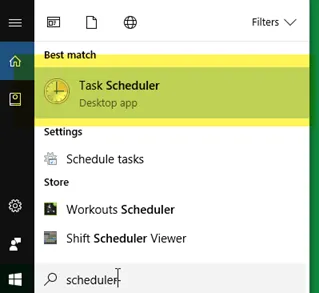
Next, select “Create Task” and the task scheduler wizard opens. It starts with the security tab: Top
Security Tab ("Runas")
This tab is important. Here you decide how your application is run- You have two plus one options:
- “Run only when user is logged in”. This is the best option to TEST your macros, as then Chrome and Firefox (and with it, Kantu) will run under your user account, just like when you manually start it. It is visible and you can check if all works well. Once that works, you can change the settings to the background (headless) mode.
- “Run whether user is logged in or not.” plus autologin: Use this option if your macro contains the real user commands XClick, XMove or XType.
- “Run whether user is logged in or not.”. This is also called “headless mode". This option makes the Chrome or Firefox browser run as a background process, even when no user is logged in. We do not recommend to use this mode, as Chrome and Firefox are not designed to work in the background mode, and often show all kinds of strange issues when used this way. This is not a problem of Kantu, but is an issue of the browsers and website. That said, for many websites this mode works well (for example, automating ui.vision, ocr.space or e. g. a google search is no problem at all). Important: If you want to run Ui.Vision RPA in the headless mode, you must check the option Run with highest privileges so the web browser (and thus Kantu) can access the internet from its background process.
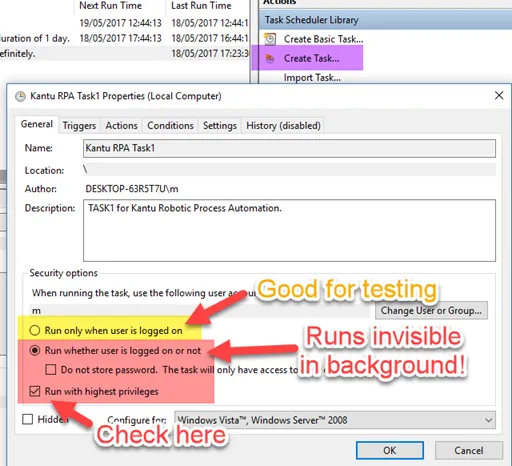
When to use what task scheduler RUN option?
Ui.Vision RPA core itself can runs in headless mode just fine. But some Ui.Vision RPA commands - by their very nature - only work in user mode and/or an unlocked desktop. For example, real user simulation commands need an unlocked desktop, otherwise there is no mouse cursor or keyboard that it can control. A real human user can also not work with a locked desktop. The table below summarizes what Ui.Vision RPA feature works headless and which feature requires an open desktop. This applies to Windows, macOS and Linux.
| Ui.Vision RPA Run Modes => Ui.Vision RPA feature: | Headless | User needs to be logged in,but screen can be locked | Desktop unlocked |
| Ui.Vision RPA Core | Yes | Yes | Yes |
| Selenium IDE commands | Yes | Yes | Yes |
| Visual UI Testing | Yes | Yes | Yes |
| OCR | Yes | Yes | Yes |
| Real User Simulation | - | - | Yes |
| Desktop Automation | - | - | Yes |
How to run desktop automation on a locked machine
Option 1: Run RPA inside a virtual machine (VM)
The most secure way to run desktop automation unattended is to use a virtual machine. For desktop automation to work, you need to keep the desktop unlocked. This is true for all RPA software tools. The best way to do this securely is to run the automation in an unlocked virtual machine (VM) inside a locked server. For the virtual machine, we recommend to use a Linux machine, since Linux VMs are much smaller and faster then a comparable Windows VM. And there are no license issues with Linux.
Option: Autologin on Windows 7, 10 and Windows Server 2016, Windows Server 2019, Mac and Linux
Autologin means that the machine unlocks the desktop after a reboot. In the Windows Run dialog box (Win Key + R), type Netplwiz and then press Enter key. Step 2: In the resulting User Accounts dialog, select your user account first and then uncheck the option labelled Users must enter a user name and password to use this computer. Click Apply button to see Automatically sign in box.
Autologin is of course also available on macOS and Linux.
The most secure way to run desktop automation is to use a small virtual machine with Linux inside your Windows, Mac or Linux host machine. This way the main machine can stay locked. This is described in next paragraph above.
Disconnecting From Remote Desktop While Running Macros with Real User Simulation
When using Remote Desktop to connect to a remote computer, closing Remote Desktop locks out the computer, displaying the logon screen. In the locked mode, the computer does not have GUI (active Window), so any currently running or scheduled Real User XClick, XMove and XType commands will fail (See also How To Run).
To avoid problems with RealUser commands, use the tscon utility to disconnect from Remote Desktop. tscon returns the control to the original local session on the remote computer, bypassing the logon screen. All programs on the remote computer continue running normally, including GUI tests.
To disconnect from Remote Desktop, run the following command on the remote computer (in the Remote Desktop window) as an Administrator:
%windir%\System32\tscon.exe RDP-Tcp#NNN /dest:console
where RDP-Tcp#NNN is the ID of your current Remote Desktop session, for example, RDP-Tcp#0. You can see it in the Windows Task Manager on the Users tab, in the Session column.
You will see the “Your remote desktop session has ended” message, and the Remote Desktop client will close. But all programs and tests on the remote computer will continue running normally.
Another option is to use Auto-Login and make sure your automation starts after a machine reboot. The macro autostart can be done e. g. with the Task Scheduler, just as described earlier on this page. In this case you can reboot the machine just before disconnecting the RDP session, and the Ui.Vision RPA macros will resume their work after the restart. This is what we use on our own test machines.
TopTrigger Tab
On this tab you select when and how often you want to start the process. In this example the process starts at Windows starts and then runs every 5 minutes
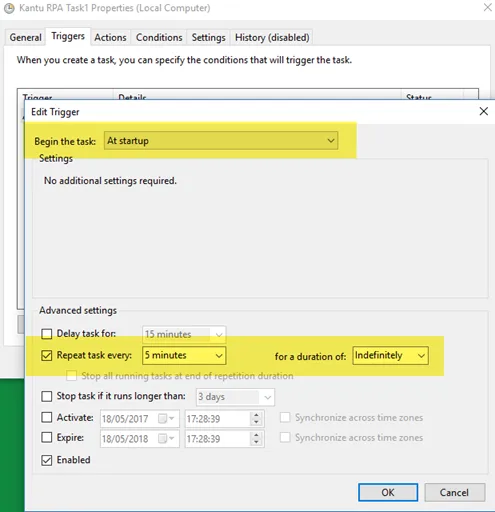
Insider tip: Note that when you set a start time, e. g. 9:00 am and want to test it a bit later, maybe at 9:30am, nothing will happen for the next 23 hours. So the 9:00am start is not trigged until the next time it is actually 9am.
TopAction Tab
Use the “browse” button to locate the program or script you want to start. If you want to use the Ui.Vision RPA command line directly, the program to start is Chrome or Firefox. Alternatively you can also start a Powershell or Python script, and then this script starts the browser with the Ui.Vision RPA Core extension.
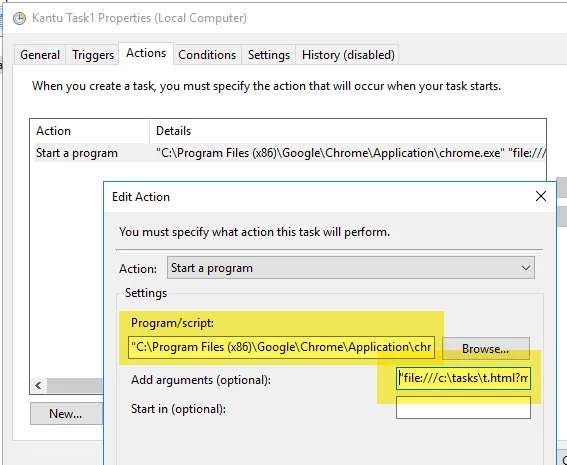
We recommend the "Start Ui.Vision RPA indirectly via a script" option (see the screenshot below), as this gives you more control and is easier to test and debug. You find example scripts for both languages in the Ui.Vision RPA github repo.
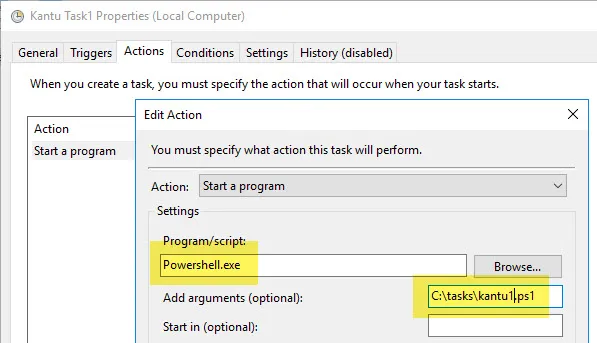
Settings Tab
Nothing to do here. If you selected “Run only when user is logged in” in on the first tab, just click. If you had chosen the “Run in background” option, the scheduler prompts you for the user name and password under which account Ui.Vision RPA should run. Make sure that Ui.Vision RPA has actually been installed in the user account that you enter here. That is all, the scheduled task is set-up.
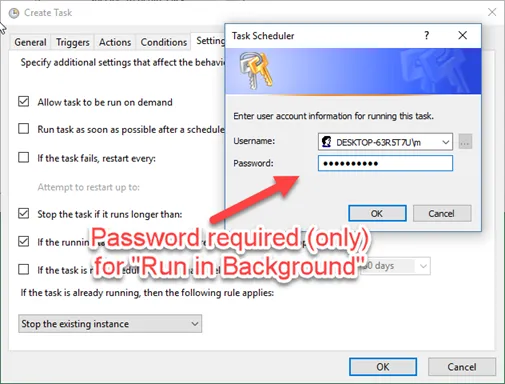
Test and debug Windows Task Scheduler
For testing, select the task, right-click on it and select “Run”. If you selected “Run only when user is logged in” in on the first tab, the browser and Ui.Vision RPA will now start and run the macro. If you had chosen the “Run in background” option, the browser and Ui.Vision RPA will also start, but you will see nothing, as it runs as background process.
Check return code
If a task ran successfully, the return code is "0x0":

Check background process
Moderate CPU usage, some file usage and some internet activity are the sign of a healthy instance of Ui.Vision RPA or the SeeShell browser:
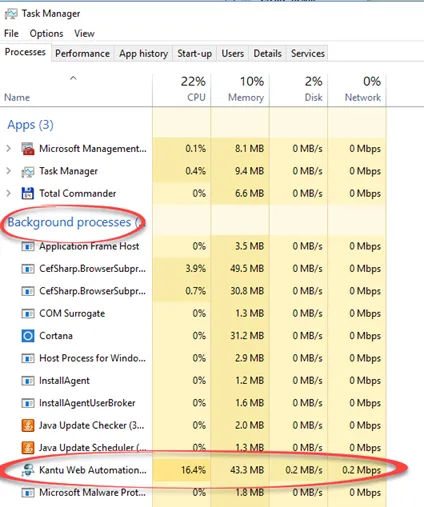
The screenshot shows a SeeShell Browser instance. For Ui.Vision RPA, you can check the Chrome and Firefox processes, as Ui.Vision RPA "lives" inside these web browsers.
Questions? Suggestions? Ui.Vision RPA tech support can help. Top